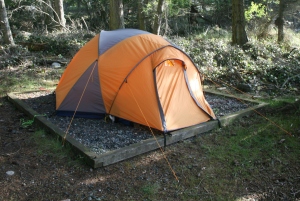Designing a reliable wilderness tent isn’t easy. It must stand up to heavy weather, yet be light and fold quickly to stow into a hiker’s pack or paddler’s boat. The brute force solution to the need for strength ̶ substantial materials like logs or stone ̶ isn’t an option.

That’s why most tent designs use some variation of skin-over-frame construction. At one time tent walls were literally skin, the hides of indigenous animals. Next came canvas, now replaced with gossamer-light synthetic fabrics waterproofed with silicon coatings. Frames of fresh-cut tree poles have given way to skeletons of aluminum or carbonfibre.
High-tech materials let today’s designers run wild with organic curves and complex shapes, but most of these experiments still rest on a skin-and-frame foundation. And for good reason: as folk engineers confirmed through eons of trial and error, no other combination beats it for lightness and durability. The secret lies in their complementary strengths.
 Frames have great compressive strength; they stand up well to being squeezed or crushed. Skin, the tent’s fly, has excellent tensile strength, or resistance to tearing. In a well designed tent, once the fly is staked out, it fits like a drum skin, its downward hug bracing the frame, which in turn braces the fly with its rigidity.
Frames have great compressive strength; they stand up well to being squeezed or crushed. Skin, the tent’s fly, has excellent tensile strength, or resistance to tearing. In a well designed tent, once the fly is staked out, it fits like a drum skin, its downward hug bracing the frame, which in turn braces the fly with its rigidity.
In heavy wind, a tent’s fly becomes a vast sail, with the tent poles as masts. Like real masts, they may not stand up to huge wind loads on their own. So just as a boat designer uses ropes or cables to brace masts, the tent maker uses guylines.
The wise designer equips even freestanding tents with plenty of attachment points for guylines, and the wise camper uses them. Because they’re contributing their tensile strength, guylines add lots of reinforcement for little weight and packed volume. (Compare, in your mind, the size and bulk of a pole strong enough to withstand a couple of hundred pounds of crushing force with a guyline that can withstand an equal amount of tearing force.)
A guyline is only as strong as what its far end is anchored to, so when dark clouds on the horizon or an electric tingle in the air warn of coming gusts, I don’t limit myself to simple stakes pounded into uncertain soil. I run guylines to rocks, roots or stuffsacks filled with sand and buried in the beach. If the tent designer is the architect, I’m the on-site supervisor, putting my home for the night up in a way that takes maximum advantage of the tent’s own materials and the strength of the Earth itself.


Hi Philip,
Some time ago I noticed that you were giving away issues of Sea Kayaker. I have donated the entire 30 volumes of SK to my alma mater, University of California, Santa Barbara. The only issue I am missing is February 2008. Perhaps you can see if the individual you gave yours to might be interested in selling that issue? I would be happy to pay a fair and good price and cover shipping.
Thank you for your consideration of this request.
Happy paddling!
Don Krueger
LikeLike
Hey Don,
Thanks for your interest. Unfortunately, there was no copy of that particular issue in the bunch I was giving away. At one time, the Ecomarine kayak store (ecomarine.com) on Granville Island here in Vancouver was selling back issues of Sea Kayaker. Perhaps contact them to see if they have it and are interested in mail ordering it to you.
Happy, safe paddling.
Philip Torrens
LikeLike